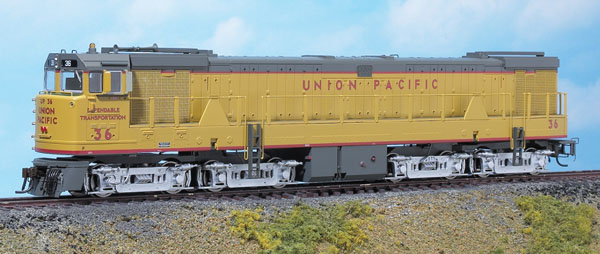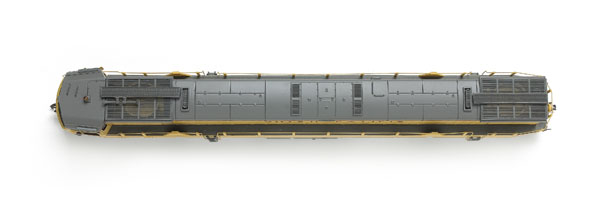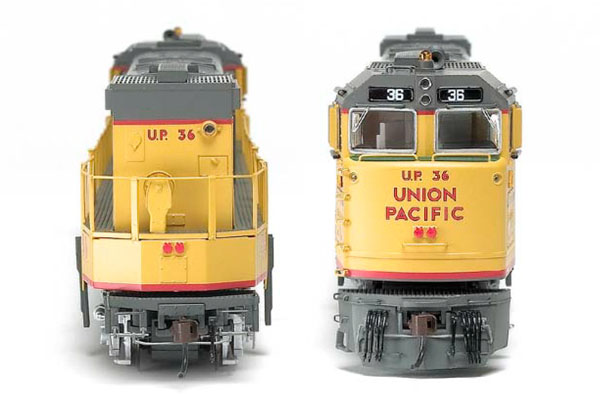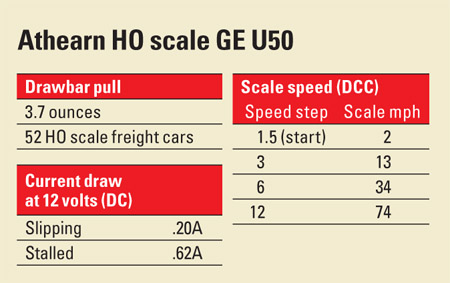The prototype. General Electric delivered 23 5,000-hp U50 diesel electric locomotives to the Union Pacific from 1963 to 1965. The locomotives were meant to serve UP’s requirement for a diesel-electric replacement for its gas-turbine-electric fleet. The Southern Pacific also purchased three U50 locomotives. General Electric reused the four-axle trucks on span bolsters from the UP’s 4,500 hp “Veranda” gas-turbines for the U50s.
The U50 was essentially two U25Bs put together. The locomotive had two FDL-16 2,500-hp 16-cylinder diesel engines. The front engine generated power for the two front trucks, and the rear engine powered the two rear trucks. Because of reliability issues, the UP retired all of its U50s by 1977.
Between 1969 and 1971, the UP purchased 40 U50C locomotives. Among other modifications, the U50Cs rode on six-axle trucks from retired 8,500 hp gas turbines. These locomotives were retired by 1978.
The plastic body shell has crisply molded equipment doors and other details. The walkways along the hoods have prototypical safety tread. The Athearn model features many separately applied parts, including scale profile hand rails, m.u. hoses, and ladders.
The U50 has separately applied radiator fans and see-through grills on the roof. Standout details are the equipment blowers behind the cab and at the rear of the hood. These are visible from the sides behind etched-metal screens. Just like on the prototype, you can see through the locomotive at these locations.
The painting and lettering on the model match prototype photos. The Armour Yellow, Harbor Mist Gray, Aluminum, and Striping Red paint match official color drift cards from the UP. Printed General Electric builder’s plates are in the correct locations along the sills under the cab.
Athearn also sells an SP version that’s detailed to match that prototype.
The motor and flywheels are mounted in the center of the chassis. The two inboard trucks are geared to the motor, while the two outboard trucks are free-rolling. All the locomotive’s metal wheels pick up track power.
A printed-circuit (PC) board is mounted over the rear half of the chassis. A wiring harness attached to this PC board has a DCC socket that will accept an eight- or nine-pin DCC decoder. The factory-installed jumper board must be removed before decoder installation.
There is a 1.2″-diameter speaker opening with sound holes at each end of the frame. SoundTraxx (SoundTraxx.com) sells a decoder and speaker kit for this locomotive. QSI Solutions (qsisolutions.com) is also offering its Titan stereo DCC sound decoder with appropriate U50 sounds.
The headlights in the model are 1.5 volt bulbs. However, Athearn has designed the lighting system so that you don’t need to install a resistor when converting the model to DCC.
The headlights turn on or off according to the model’s direction. There’s also a non-operating warning beacon on top of the cab roof.
The U50 ran on 18″ radius curves, but it looks more realistic rounding broader curves. It also didn’t have any difficulty going forward or backward through a no. 6 turnout.
Manufacturer
Athearn Trains
2883 E. Spring St., Suite 100
Long Beach, CA 90806
athearn.com
Road names: Union Pacific (four road numbers), Southern Pacific (three road numbers)
Era: 1963 to 1977 (Union Pacific)
Features
- All-wheel electrical pickup
- DCC socket accepts eight- or nine-pin decoder
- Five-pole skew-wound motor with dual brass flywheels
- McHenry scale-sized operating knuckle couplers at correct height
- Metal wheels in gauge
- Minimum radius: 18″
- Weight: 1 pound 11 ounces


















